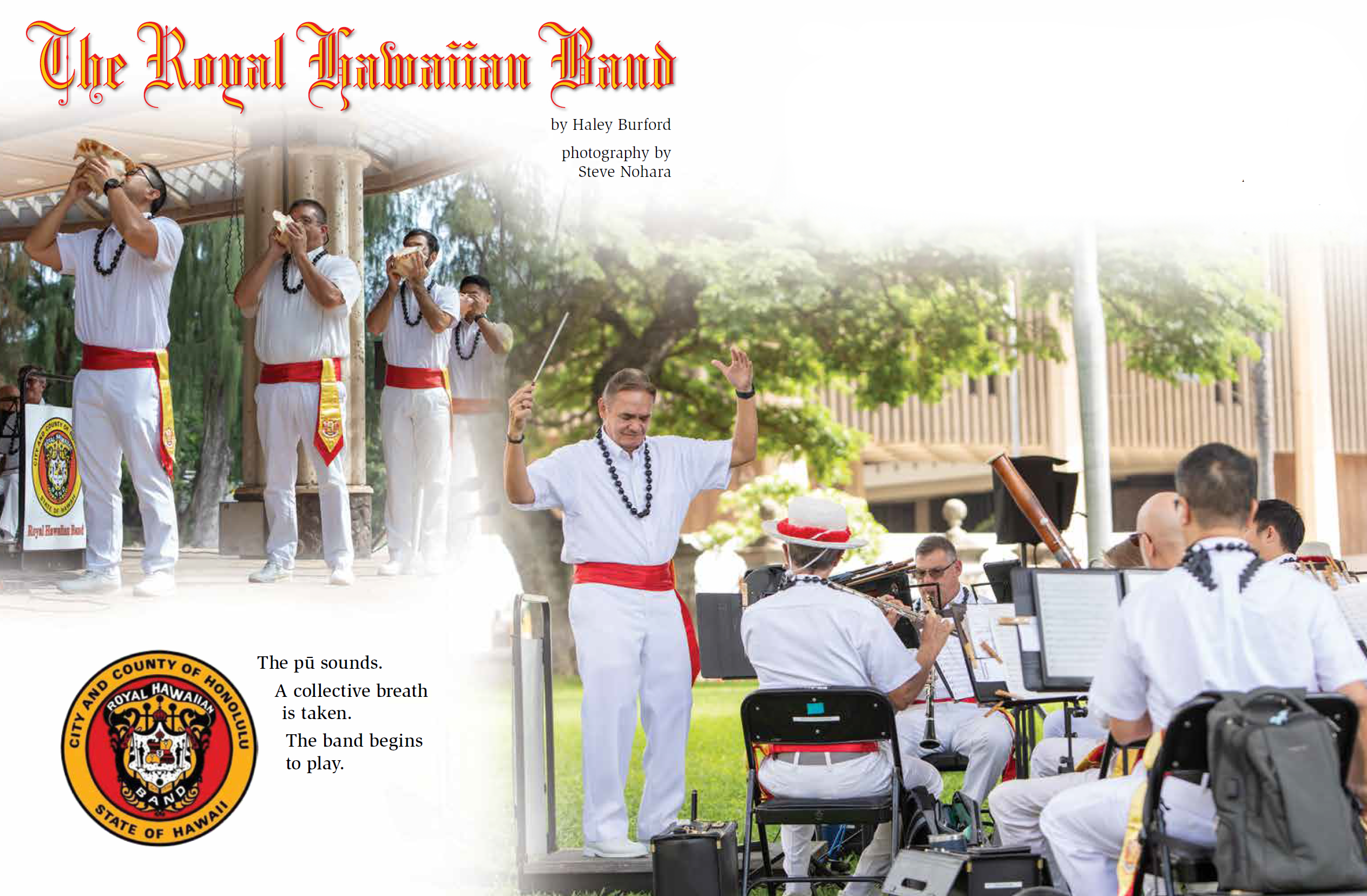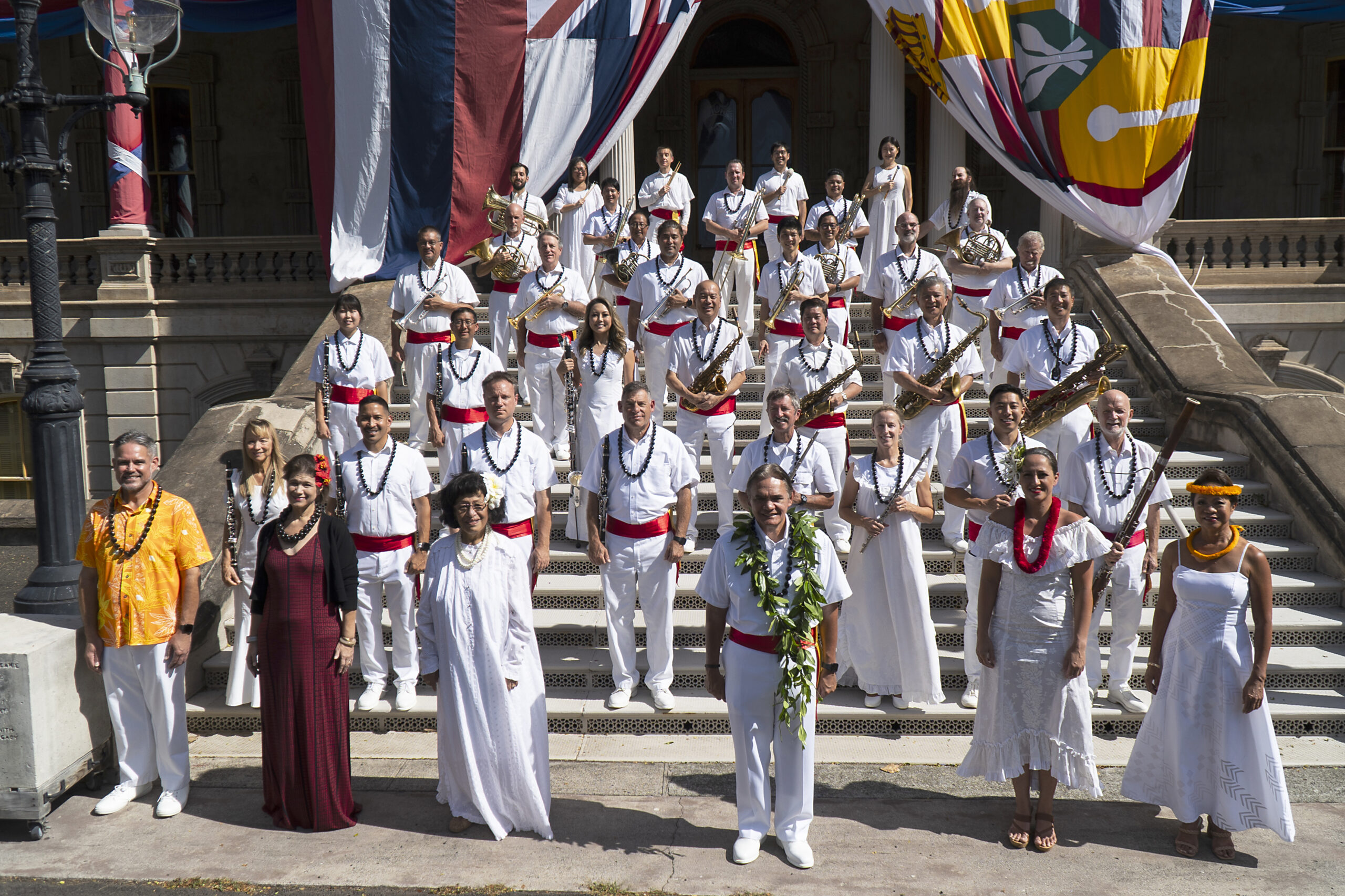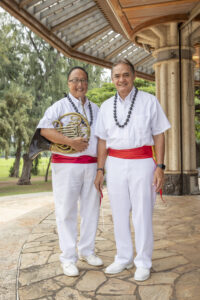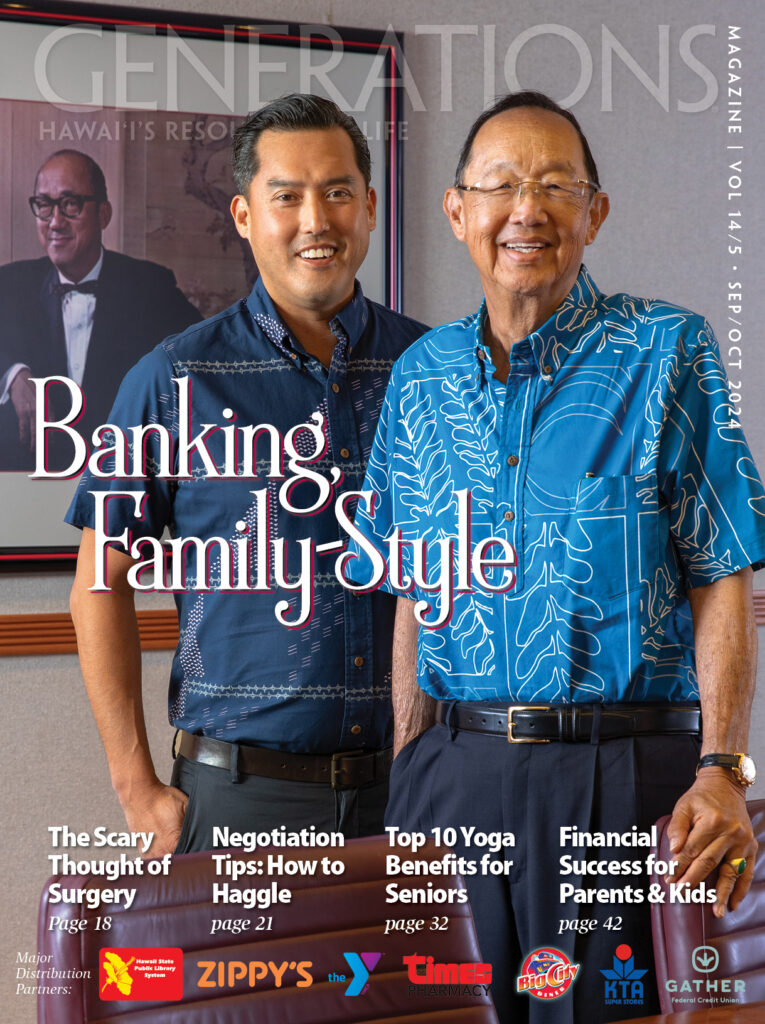 “To promote and foster music, preserve the Hawaiian musical culture, inspire young musicians and enrich the lives of the people of Hawai‘i” is their mission. As the only full-time municipal band in the United States — and the only one with a royal legacy — the Royal Hawaiian Band has touched and continues to move the hearts of people young and old for almost two centuries, beginning with their founding in 1836 by King Kamehameha III, Kauikeaouli. On top of weekly concerts at ‘Iolani Palace and Kapi‘olani Park, the band plays at over 300 events every year. They are led by Bandmaster Clarke Bright, who has conducted the Royal Hawaiian Band since 2011. Next to Clarke is Eric Kop, the assistant administrator and principal horn of the band. Together with other members of their staff, the Royal Hawaiian Band successfully and with great pride serves the people of Hawai‘i and encourages everyone to participate in the universal language of music.
“To promote and foster music, preserve the Hawaiian musical culture, inspire young musicians and enrich the lives of the people of Hawai‘i” is their mission. As the only full-time municipal band in the United States — and the only one with a royal legacy — the Royal Hawaiian Band has touched and continues to move the hearts of people young and old for almost two centuries, beginning with their founding in 1836 by King Kamehameha III, Kauikeaouli. On top of weekly concerts at ‘Iolani Palace and Kapi‘olani Park, the band plays at over 300 events every year. They are led by Bandmaster Clarke Bright, who has conducted the Royal Hawaiian Band since 2011. Next to Clarke is Eric Kop, the assistant administrator and principal horn of the band. Together with other members of their staff, the Royal Hawaiian Band successfully and with great pride serves the people of Hawai‘i and encourages everyone to participate in the universal language of music.
The History
Clarke Bright was appointed bandmaster by then-Mayor Peter Carlisle; the Royal Hawaiian Band is an agency of the City and County of Honolulu. The history of the band is available on their website, but Bandmaster Bright breathes life into the facts through his passionate storytelling.
The Royal Hawaiian Band has always existed under the leadership of the current ruling party. “The Hawaiian culture had lost its voice when they lost the last reigning queen, and it was important to keep that going in some format because we had lost leadership — we lost our kingdom,” says Clarke. “We were then under the rule of a territorial-type government and the Hawaiians knew it was important to preserve their voice.”
Prince Kuhio knew it. “He went to Washington, DC, as a delegate to Congress — he had no voting position, but he did whatever he could to make it known to the American government that the culture needed to continue to be part of who we are. He then came back and he realized that the best way to keep Hawai‘i’s voice going was to have a government, like a city entity, that would be voted on by the people of Hawai‘i. He reengaged the Royal Society — the Royal Order of Kamehameha — to give their voice more prominence. He engaged the Hawaiian Civic Clubs and continued to work for land acquisition in and amongst the Hawaiian area — all of those things he did to continue to give Hawaiians more of a voice.”
Clarke feels that one of the most important things Prince Kuhio did was tag the band onto city leadership. With the band under the auspices of the city, the band’s musical voice, its historical voice, its hula and its prominence in culture would continue to give Hawaiians a voice under a ruling government. “And that’s where we are today,” says Clarke. “From day one, the Royal Hawaiian Band has been part of the city. And we continue, I believe, to give a prominent Hawaiian voice to the culture of Hawai‘i.”
For 188 years, the Royal Hawaiian Band has played for audiences locally and internationally a plethora of musical arrangements — from contemporary and traditional Hawaiian music to Broadway and symphonic compositions. The band also plays music composed by Na Lani ‘Eha — the Royal Four — and pieces of Hawaiian music stylized by former bandmaster Henry Berger to evoke various European musical forms such as marches, polkas and waltzes.
Among the pieces the Royal Hawaiian Band plays that are composed by Hawaiian royalty, the most famous, “Aloha ‘Oe,” was composed by Queen Lili‘uokalani. The heartfelt, moving classic closes every single Royal Hawaiian Band concert. In the early 1900s, the Royal Hawaiian Band adopted many hapa-haole (Hawaiian music with English words) pieces into its repository. These pieces, such as “Waikiki,” “Sophisticated Hula” and “Hukilau” can still be heard today at their concerts.
But, Hawaiian music is not all that they play. The Royal Hawaiian Band also performs and arranges many pieces from the US and across the globe, traversing time and space to bring audiences the wonder and beauty inherent in music. Their concerts today include marches, orchestral transcriptions, standard band repertoire, pop music arrangements, Broadway musicals, movie soundtracks and television show theme songs. The band also is well-versed and takes pride in their extensive catalog of ethnic folk songs when taking part in many of the cultural festivals in Honolulu.
Perhaps one of the most intriguing things about the Royal Hawaiian Band staff, too, is that they have staff arrangers who, at the assignment of the bandmaster, create arrangements of these ethnic folk songs for the band and for the audience’s enjoyment. Eric Kop, assistant administrator and principal horn of the Royal Hawaiian Band, articulates some of the work that is put into these arrangements:
“When we go to the Palolo Chinese Home, we have a library of Chinese folk songs that we’ll play,” says Eric. “Depending on the communities that we are playing for, we will actually tailor the program for the particular ethnicities that are represented there. Most of the arrangements we play are made especially for the Royal Hawaiian Band; no other music entity has those arrangements, so I think that’s a very unique part. Really, when I see the reaction of the audience, whether it’s kūpuna or the youth, I know that we are accomplishing our mission — enhancing life. And just to see the smiles… you know we’re doing what we set out to do, and that’s a great thing.”
With such an abundance of music to choose from, a lot goes into preparations for their hundreds of annual concerts. According to Clarke, “It really starts with the request from the entity that wants us there. Once the schedule is there, I take a look at what might be appropriate. We create a program and hand it out to our members at least a week before the concert. Then, we meet and decide what’s the best way to serve that concert.”
Clarke and Eric go on-site about an hour-and-a-half prior to downbeat. They lay out markers for the design of the band. They unload the equipment from their truck an hour before, set up and the band members warm up a half-hour later. Announcements are made 15 minutes before, and the tuning note sounds five minutes before starting the 45-minute to one-hour concert.
“We usually have an opening involving the pū , or conch, and an ‘oli to welcome the audience,” says Clarke. “And then, depending on where we’re at, we may focus more on contemporary or traditional Hawaiian music. We’ll usually play something that’s good or challenging for the band, like a symphonic piece or a band standalone. We play modern, easy-to-listen-to music, like Broadway or contemporary hits for the audience.”
The Royal Hawaiian Band also performs weekly concerts on top of being available for request. About these routinely scheduled performances, Clarke says, “We have some standing weekly concerts at ‘Iolani Palace on Fridays and at Kapi‘olani Park on Sundays. But other than that, the majority of concerts are requested either by educational institutions, nonprofit organizations, community events or government events of that nature.” The band also reaches out to be a part of other important concerts, including anything that the mayor — or the governor — initiates, as well as meaningful Hawaiian-related events.
“I want to make sure we’re at things like birthdays of kings or queens, celebrations of lei draping, those kinds of things,” says Clarke. “Part of our purpose is to also serve the people who are of early age and those who are more in the latter part of their lives.” From elementary school-type educational concerts to performances for seniors in living and care centers, the Royal Hawaiian Band is eager to reach out to such organizations every single year.
Clarke is the most recent torch-bearer in a legacy of bandmasters for the Royal Hawaiian Band. He grew up in a music-oriented family, helping with his father’s theatrical musical productions growing up then majoring and graduating with a bachelor’s degree in secondary music education from the University of Hawai‘i. He was the band director at Waimanalo Intermediate School for four years, then at Kamehameha Schools for 13½ years, teaching all grade levels, until he was appointed bandmaster of the Royal Hawaiian Band in 2011.
A great leader is one who empowers others. The conviction with which Clarke describes the bandmaster’s responsibilities communicates his ability to move others, not with force, but through and for the love of Hawaiian culture and music. He emphasizes that he finds it important to remember that his main responsibility is service — to the band, to the city and to the people.
“I have to, of course, conduct the band, but I choose the music and we rehearse the organization,” says Clarke. “I’m responsible for the vision and leadership of the organization, as well.” As part of the city’s cabinet, he attends mayoral cabinet events and administrative meetings.
Clarke also makes a point of partaking in the culture that surrounds the band and their music. “The Hawaiian culture is so special… Being Native Hawaiian myself, I think it’s important for the Hawaiian people to know that we are serving them as best as we possibly can. It’s a big responsibility — to show up at all these events, to meet with them, to befriend them and to ensure they know that they can trust that their band can serve them as needed. The community has to see their bandmaster as somebody who wants to serve them — who wants to bring music out to the people. I think that’s important, too. So, the main thing is service. It’s a very diverse position. It really requires many different facets of a person, but it is a position I am honored to participate in.”
The Backbone of the Band
Clarke does not shoulder the responsibilities of maintaining the Royal Hawaiian Band alone — the band has a staff of 10, all of whom play their respective instruments. Another vital position is that of the assistant administrator, covered by Eric Kop, who is also the principal horn.
Eric began with the Royal Hawaiian Band in 1988 at the age of 21. Through his years in music and passionately advocating for music education, he has previously taught horn for the University of Hawai‘i at Mānoa, the Hawai‘i Youth Symphony’s Pacific Music Institute, Mid-Pacific Institute and in his own private instruction studio. Eric has also backed legendary musicians in his time as a freelance musician, including Frank Sinatra, Liza Minnelli, Charlotte Church and others.
As the band’s assistant administrator, Eric works closely with the bandmaster, handling logistics and ensuring the band and their performances run smoothly. “During the concert, I am playing the principal or first horn part. So, I perform as a musician. In the office, I do a lot of the work for the auditions.” He also works with departments outside of the Royal Hawaiian Band regarding fiscal matters, human resources and anything interdepartmental within the city.
At this, the bandmaster speaks up. “Eric basically said what’s supposed to be said on paper, but in addition to all of that, he is directly responsible for our link to the city — probably one of the most important positions in the band,” says Clarke. Clarke stresses how instrumental the assistant administrator is in that Eric communicates with the city to ensure that “this very un-city-like entity,” the Royal Hawaiian Band, is seen by the city how it is supposed to be. Such a position involves quick thinking, and Eric’s masterful way of translating musical to municipal and vice versa is something that Clarke feels really keeps the band on track.
The Business of Music
As part of the band staff working under the city, both Clarke and Eric underline some of the challenges that come with being an arts organization under city jurisdiction. Though they are a city agency, the city does not organize for the band. Eric says, “In order to incorporate city work policies and what employees in other departments do within our arts organization, we have to convert it. When you’re dealing with artists who are not used to a regular 9-to-5 schedule, that’s sometimes a challenge because we work such an odd schedule — it’s all over the place…” A lot of work is put into translation, and when information has to be circulated through different checkpoints and departments, communication is key to the Royal Hawaiian Band’s success.
Though this work of translation can be tough, Eric takes great pride in handling the challenge: “To bridge the translation gap presents a unique challenge.” Clarke adds, “And he does it really well. We take pride in the fact that the city and state understand the importance of perpetuating our culture through music, dance and hula — that they deem it appropriate to have a full-time organization sponsored by city support for the perpetuation of Hawaiian music.”
The Band for Kūpuna
The Royal Hawaiian Band boasts 40 members, with seniors making up about 25% of its roster. Out of over 300 every year, their proudest concerts are for seniors, whether at community centers, housing or at public performances. According to Clarke, “We’re really proud of many things that we do, but that service to the seniors is a very important aspect of who we are. The biggest thing is the genuine appreciation that they have for what we bring. In every single senior environment — because most of the music that we do for them, they know — they’ve either sung to it or danced to it at some point in their lives. The music hits in a certain way that other things cannot.
“Music is so powerful in that aspect,” says Clarke. “It’ll bring back a memory; a season in their life; a time. It’ll do things to your heart that are very hard to describe or quantify in government processes, but the aesthetic value that we bring in our music, singing and hula is special.”
The Royal Hawaiian Band goes out to the people. “The appreciation we get from seeing their faces is really wonderful to us.”
Clarke recounts a story that holds a particularly special place in his heart. “Early in my tenure, we went to one of the senior centers. A lady was walking right in front of the band from one side of the stage to the other with her walker — right before we were going to start. As she labored with her walker, I just waited. I waited and I waited… for maybe four or five minutes. She sat; we started.
“In the concert, we played a song that I believe struck something in her na‘au — her heart or her spirit — and she remembered, I think. She got up from her chair, she moved her walker aside and danced the hula to that song we were playing. I couldn’t believe it. I turned around. It actually made me emotional. Then, she labors back down with her walker into her chair. At that point, I just thought, that’s the power of music. How else will somebody feel a certain part of their past, resurrect it and perform, other than through music of their era or their generation? It’s so important for us to serve that part of the community that needs to be served in the best way possible. I’ll never forget that.”
All throughout history, the human love for music has continued to withstand the test of time. People of all ages can understand and bond over music. “Music is such an emotional language, right?” says Eric. “It represents history; it represents culture; it represents the people. And, like Clarke said, we’ve seen so many of our audiences get very emotional during the performances.” For Clarke and Eric, playing music with the Royal Hawaiian Band is a gift given to the community that also gives back to the band. As a universal language, one without words, music moves us — to a dance or to a memory.
The Legacy of the Band
The Royal Hawaiian Band is meaningful to the community and its members because of the music that they play for others, but the band is precious and an integral part of the individual members and Hawai‘i state pride, too, because of the sentimental value it holds across its history. Eric never tires of growing with the band. “Over the course of 35 years — now at the other side of it — I’ve really cherished and valued how we affect the audience members and for me, personally, that sense of duty. As one of the senior members, I feel a duty to be part of the stewardship of the band and to make sure that its legacy continues.”
Clarke also feels such a responsibility to build the band up to be the best it can be while also maintaining its long-standing reputation as Hawai‘i’s band. “My number one mission is to preserve this organization into perpetuity, and I do that by ensuring we are hitting the mark. If we are being requested by a government agency, hit the mark; a community agency, hit the mark; with the culture, Hawaiian culture especially, or anything to the seniors and young students, hit the mark. Make sure we’re serving them well.
“It’s also to serve the members,” says Clarke. “If I’m thinking of serving them, I’m ensuring they get whatever they need to be successful. We are serving the members who then serve, through their music, the audiences that we play to.”
These professional responsibilities are a major part of working with the Royal Hawaiian Band, but what the work also encourages, fosters and requires is a genuine love of music. Both gentlemen found their passion for music very early on in their lives. When asked what fuels their love for music, both Clarke and Eric recall their upbringing fondly.
For Eric, his earliest influence was his mother. “She would always be playing the record player. So, as a young child, I grew up listening to a lot of classic Broadway and light classical music.” As he grew older, what continued to motivate Eric as a brass instrument player — a French horn player, specifically — is the physicality and sound of the horn. “I remember first recognizing what a French horn sounded like when I was watching Star Wars, and that really hooked me into that sound.” As far as music goes, he listens to everything “from Tchaikovsky to K-Pop.” To him, “good music is good music, no matter what the genre is.” He feels that being a part of music production is a thrill that contributes to and strengthens his lifelong love for music.
Clarke tells the story of being told by his parents that he could keep a beat on a pair of bongos gifted to him by his father when he was only 6 months old. His father was a musician and musical theater director, so music was very much present in his home growing up. Through assisting his father with his productions, Clarke saw what the arts — not just music — can do to and for people. Though he wasn’t aware of his bongo-playing at such an early age, Clarke is sure that music has been his life’s calling since the beginning, drawing much inspiration from his father. “I was immersed in all of this music and he, being Hawaiian, played piano and knew a lot of Hawaiian songs. He played often with various Hawaiian singers and would also bring me along, his drummer son, to assist in all of his events or concerts or shows. And when I think back on that rearing, I think I was meant to serve musically, in some capacity, the community at large. That fuels my love for music.”
As he grew older, the simple love for music transformed into scholarly study, learning the names and theories and backgrounds of different transitions, keys and chords. Clarke credits his father for encouraging him to conduct one of the shows. “He had faith in me and kept believing in me, so I did it.” He went on to formally study and teach music, leading up to his work with the Royal Hawaiian Band as the bandmaster. “That passion, the genuine love of music — not only for music itself, but what it can do to serve others — really moves me. That really gets me going. I love to listen to it, I love to perform it, I love to conduct it, but it’s when it serves others that it really fuels me and keeps me going.”
The Community’s Band
The Royal Hawaiian Band loves to serve all the various agencies and communities, but, most of all, they want everyone to know that the Royal Hawaiian Band is their organization. “We want them to feel like they can ask for us to be there whenever they want,” says Eric. “Never be afraid to ask — we are there to serve them.”
“It really is Hawai‘i’s band, because there’s so much of Hawaiian history built into the music that we play,” says Clarke. “When audience members come to hear the band and they listen to the introduction of how a lot of these songs are weaved into Hawaiian history, it really ties into our mission to perpetuate the music and educate people. We hope to get that mission and message out to as many people as we can.”
Aloha ‘Oe
Music knows no age; it knows no boundaries. As the Royal Hawaiian Band continues to play and serve the people of Hawai‘i, they also fulfill their mission statement, going above and beyond to communicate their love for music and performing their arrangements. To promote and foster music, the bandmaster and assistant administrator/first horn Clarke Bright and Eric Kop, together with all the other members of the Royal Hawaiian Band, play their music for the people in Hawai‘i and across the world, from the beginning to now and into the future.
To preserve the Hawaiian musical culture, the band upholds Hawaiian traditions and maintains the legacy of Hawaiian music through passionate performances. To inspire musicians, young and old, and enrich the lives of the people of Hawai‘i, the Royal Hawaiian Band proudly continues to perform at over 300 events annually, giving it their all at every single concert. With the opening notes to Queen Lili‘uokalani’s “Aloha ‘Oe,” the Royal Hawaiian Band’s performance ends with a gesture of love to Hawai‘i and its people. At the very end, a clear promise is made to their audience: Until we meet again.
RELATED STORY: The Language of Emotion by Haley Burford
For more information regarding the Royal Hawaiian Band, the band members, contact information to request an appearance and a running schedule of their upcoming events, visit the Royal Hawaiian Band’s website at rhb-music.com.





Leave a Reply